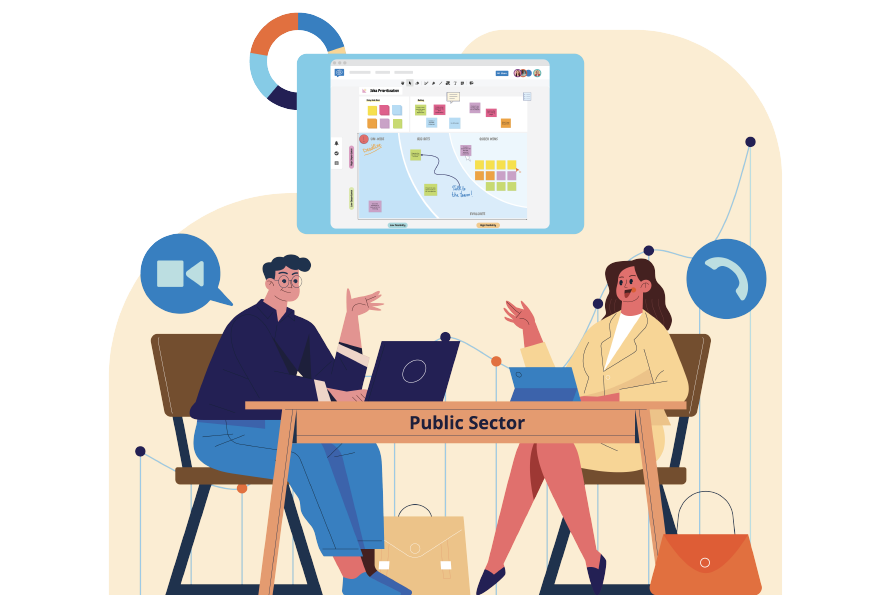Keeping everyone fully engaged during virtual meetings has always been a challenge. With the sudden increase in work from home and the use of tools like Zoom and Teams, engagement in meetings has both become more important, and more difficult.
Engagement is key to ensuring meetings deliver the best answers and building commitment to them. It is also a big factor in maintaining relationships, developing trust, improving staff satisfaction and retention. And during the current crisis, it is all the more important that people feel they are still part of a team.
But in most virtual meetings, it can be difficult to gauge whether people are engaged or not. The challenge is finding new ways to ensure those who are at risk of becoming disengaged are fully drawn into the discussion.
The differences between the physical and the virtual meeting environment mean that we have lost a lot. But the differences also mean that we have gained a lot that many of us have not yet tapped into. For example, simple, quick and easy ways to engage people and to keep that engagement going.
In this short article, we will not only introduce some of these, we will also provide you with a free resource you can use in all your future meetings. You can get your own copy here – it contains all of the tools below. All of these tools are in the form of micro-polls – simple checks that take no more than five seconds. They are a great way to start building engagement, and when you are ready to build on that, we have a whole host of other engagement resources available for you.
Yes / No Check
A common way to engage people in meetings is to simply ask ‘Any questions so far?’, or ‘Is this making sense to you?’. In a physical meeting, this would attract nods or shakes of the head, and muttered ‘yeps’ or ‘nopes’. You would scan the room as you asked the question, and immediately spot any ‘blank’ responses and gently call them out … ‘Andrea, Jack ???’
However, in virtual meetings, people are often on mute, and some webcams are not showing, and the most common response tends to be silence, which is accepted as the default answer. But it gives you no idea of who didn’t respond because they are okay, and who didn’t respond because they are becoming disengaged.
The Yes / No Check uses a simple whiteboard panel to get people to move their cursors over yes or no in response to the question. Cursors that haven’t moved are clearly identifiable – Andrea and Jack – and this enables you to follow up.
Alternating ‘Any questions so far?’ and ‘Is this making sense to you?’ has the effect of changing the default answer, and helps to keep people on their toes (i.e. ‘engaged’)
Access the simple graphic tool here.
Status Tracker
The status tracker is a tool that enables real-time feedback on presentations regarding agreement, speed, queries etc. In theory we could track this through watching people’s faces, but that is not always possible, and furthermore presenting in a virtual environment can be more complex, and take more of our attention away from the audience.
Simply ask people to place their cursors on ‘okay’, and move them if they wish to raise a question, suggest a change of pace, or provide encouragement. You can intersperse this with the Yes/No Check above to ensure that those on ‘okay’ have not fallen asleep.
Access the simple graphic tool here.
Mood Indicator
This can be used at the end of any particular section of the agenda to take a quick poll of how people feel the meeting is going. It gives an opportunity for people to either indicate their support of the conclusions so far, or to flag any concerns, which can then be addressed.
Access the simple graphic tool here.
Straw Poll
Web conferencing tools often have polling tools included within them. However, they are not used much, partly because of the (organizational) practicalities involved in setting them up. An alternative is for presenters to include polls within their slide deck where each answer is associated with a different number or color.
The Straw Poll is simply a panel of those numbers and colors positioned so that people can quickly indicate their answer by placing their cursor on the panel. In this way, people can both engage and contribute quickly and easily to an emerging picture.
Access the simple graphic tool here.
Meeting Check-in
The Meeting Check-in is an easy way of getting basic participation right from the start of your meeting. Simply ask people to place their cursor over the emoticon that most closely represents how they are feeling on arrival at this meeting. You can then get people to talk about this in the same way that you would in a normal check-in. This can be really helpful to people who are feeling distanced from their colleagues as a result of working from home.
Access the simple graphic tool here.
Readiness Check-in
One of the biggest causes of inefficiency in meetings turns out to be people’s preparation before attending the meeting – not completing actions or doing the pre-reading. Furthermore, its effects are insidious – when it happens, you need to compensate, and this makes it more likely that people will rely on that compensation next time around.
The Readiness Check-in is simply about making this issue transparent. People place their cursors on the Venn Diagram according to what they have done in preparation.
With many people, making readiness visible from the outset is often all that is required for them to self-correct. And for others, correction can be influenced by gentle off-line discussions. The action of simply making it visible and important is often enough to get it fixed. And if it isn’t, then the picture can be used as the basis of a general discussion of its implications, and a team contract on ‘how we want to be’ going forward.
The more prepared people are, the more likely that they will use that knowledge and insight to participate.
Access the simple graphic tool here.
Other tools
The simple tools above will help you increase participation and engagement. However, they are only scratching the surface of what is possible, and if they are used in isolation for a prolonged period of time, there is a danger that they may become clichéd and irrelevant. Participation is more than simply using a cursor as a flag, and the same technology which enables all of the above has much greater potential to engage people’s ideas, collaboration and commitment.
Two key tools we would encourage you to consider in this regard are;
- Hopes and Concerns – which enables people to add their own flavour to the meeting objectives and to reflect agendas which might otherwise be hidden – this immediately helps people feel that they have a stake in the meeting
- Parking Lot – which enables important off-topic issues to be handled in a way that doesn’t distract the meeting from its intended focus – this helps avoid those unconnected from the off-topic issue from losing interest
The complete set of graphic tools can be seen here.
Conceptboard Workshops on virtual meetings
In order to better equip you for a world where virtual meetings are the new norm, we have curated a series of free workshops that will focus on different aspects of virtual meetings. The first of these is a 30 minute session titled “Keeping focus and attention in virtual meetings” and will tackle the challenges of managing engagement and participation in virtual meetings. Details are as follows:
Title: Keeping focus and attention in virtual meetings
Time and Date: 22nd July, 5pm CEST
Read more about how to improve your remote meetings and virtual workshops on our blog.




